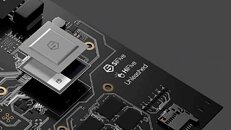- Joined
- Oct 9, 2007
- Messages
- 47,585 (7.45/day)
- Location
- Dublin, Ireland
| System Name | RBMK-1000 |
|---|---|
| Processor | AMD Ryzen 7 5700G |
| Motherboard | ASUS ROG Strix B450-E Gaming |
| Cooling | DeepCool Gammax L240 V2 |
| Memory | 2x 8GB G.Skill Sniper X |
| Video Card(s) | Palit GeForce RTX 2080 SUPER GameRock |
| Storage | Western Digital Black NVMe 512GB |
| Display(s) | BenQ 1440p 60 Hz 27-inch |
| Case | Corsair Carbide 100R |
| Audio Device(s) | ASUS SupremeFX S1220A |
| Power Supply | Cooler Master MWE Gold 650W |
| Mouse | ASUS ROG Strix Impact |
| Keyboard | Gamdias Hermes E2 |
| Software | Windows 11 Pro |
SiFive, Inc., the founder and leader of RISC-V computing, today announced it has been selected by NASA to provide the core CPU for NASA's next generation High-Performance Spaceflight Computing (HPSC) processor. HPSC is expected to be used in virtually every future space mission, from planetary exploration to lunar and Mars surface missions. HPSC will utilize an 8-core, SiFive Intelligence X280 RISC-V vector core, as well as four additional SiFive RISC-V cores, to deliver 100x the computational capability of today's space computers. This massive increase in computing performance will help usher in new possibilities for a variety of mission elements such as autonomous rovers, vision processing, space flight, guidance systems, communications, and other applications.
"As the leading RISC-V, U.S. based, semiconductor company we are very proud to be selected by the premier world space agency to power their most mission critical applications," said Jack Kang, SVP Business Development, SiFive. "The X280 demonstrates orders of magnitude performance gains over competing processor technology and our SiFive RISC-V IP allows NASA to take advantage of the support, flexibility, and long-term viability of the fast-growing global RISC-V ecosystem. We've always said that with SiFive the future has no limits, and we're excited to see the impact of our innovations extend well beyond our planet."

The SiFive X280 is a multi-core capable RISC-V processor with vector extensions and SiFive Intelligence Extensions and is optimized for AI/ML compute at the edge. The X280 is ideal for applications requiring high-throughput, single-thread performance while under significant power constraints. The X280 has demonstrated a 100x increase in compute capabilities compared to today's space computers. In scientific and space workloads, the X280 provides several orders of magnitude improvement compared to competitive CPU solutions.
The open and collaborative nature of RISC-V will allow the broad academic and scientific software development community to contribute and develop scientific applications and algorithms, as well optimizing the many math functions, filters, transforms, neural net libraries, and other software libraries, as part of a robust and long-term software ecosystem.
The HPSC processor and X280 compute subsystem is expected to be useful to other government agencies in a variety of applications including industrial automation, edge computing, ratification intelligence, and aerospace applications.
For more information on SiFive's market-leading RISC-V IP portfolio and how it is well-suited for Aerospace and Defense applications, please visit SiFive.com.
View at TechPowerUp Main Site
"As the leading RISC-V, U.S. based, semiconductor company we are very proud to be selected by the premier world space agency to power their most mission critical applications," said Jack Kang, SVP Business Development, SiFive. "The X280 demonstrates orders of magnitude performance gains over competing processor technology and our SiFive RISC-V IP allows NASA to take advantage of the support, flexibility, and long-term viability of the fast-growing global RISC-V ecosystem. We've always said that with SiFive the future has no limits, and we're excited to see the impact of our innovations extend well beyond our planet."

The SiFive X280 is a multi-core capable RISC-V processor with vector extensions and SiFive Intelligence Extensions and is optimized for AI/ML compute at the edge. The X280 is ideal for applications requiring high-throughput, single-thread performance while under significant power constraints. The X280 has demonstrated a 100x increase in compute capabilities compared to today's space computers. In scientific and space workloads, the X280 provides several orders of magnitude improvement compared to competitive CPU solutions.
The open and collaborative nature of RISC-V will allow the broad academic and scientific software development community to contribute and develop scientific applications and algorithms, as well optimizing the many math functions, filters, transforms, neural net libraries, and other software libraries, as part of a robust and long-term software ecosystem.
The HPSC processor and X280 compute subsystem is expected to be useful to other government agencies in a variety of applications including industrial automation, edge computing, ratification intelligence, and aerospace applications.
For more information on SiFive's market-leading RISC-V IP portfolio and how it is well-suited for Aerospace and Defense applications, please visit SiFive.com.
View at TechPowerUp Main Site





